As soon as we learn how to walk, human beings take off running. Putting one foot in front of the other is a great start—but there’s more to running than that. Strength, endurance, teamwork, and a sense of humor will get you over most Tough Mudder obstacles—but in between those challenges, your own two feet will do the heavy lifting. The following 6 running tips will help to maximize your run training—and your event-day fun.
6 Tips for Running Between Obstacles
1. LEARN THE THREE KEYS TO SUCCESS
To build a solid running base, try to incorporate these three key workouts into your weekly routine (with easy days in between):
Speedwork/intervals: You certainly don’t need a track for these workouts, but if you have access to one, go for it. Speedwork mean short bursts of very hard work—anywhere from 400m to a mile. In between, you’ll rest (that’s the “interval” part) for a while, but not long enough to fully recover. Speed workouts are great for every part of you—they make your legs peppier, and they prepare your brain to work hard when you’re tired.
Tempo run: Like a speed workout, a tempo run requires you to run harder than you would if you just headed out for a few miles—but not as hard as a full-out race effort. It’s a sustained effort (30 minutes is plenty for most of us) at a pace that makes it hard to talk in complete sentences.
Long run: Whether you’re preparing for the 3 miles of a Tough Mudder 5K or the 10 mile challenge of a Tough Mudder 15K or Toughest Mudder, your weekly long run will build the cardiovascular endurance you’ll need to tackle your Tough Mudder. Pace doesn’t matter so much on a long run—the key is getting the miles under your belt. If you’re just getting started, there’s no need to go as far as you will on race day—eight miles is plenty for those tackling 10 miles.
2. BUILD SLOW
The first rule of running is that if you want to be good at it, you’ve got to do it a lot. But that doesn’t mean you should dive right into the deep end. Trying to do too much too soon can lead to fatigue and injury. A good rule of thumb: Increase your mileage by no more than 10% each week—ideally on your long run.
3. HEAD FOR THE HILLS
We don’t call it a Tough Mudder because it’s easy—in between the obstacles, you’ll also find hills. Hill workouts will prepare you to do battle with gravity on race day (they’re also speedwork in disguise). Run hard to the top of a hill (a quarter mile should do the trick), then jog back down, catching your breath. Repeat 4-6 times. In the race, try to run even effort on the hills. That might mean your pace slows a bit as you climb, but you’ll conserve energy for your next obstacle.
4. FOCUS ON FORM
Hill repeats and speed workouts require runners to focus on form. When you’re working hard, think about using your core to lift your knees, driving off the front part of your foot, and swinging your arms a little harder. Stand up tall, with your neck and your shoulders relaxed—that way, your lungs have more room to expand with air. And when you’re coasting downhill, relax just a bit and let gravity help you out.
5. TAKE IT EASY, KILLER
You signed up for a Tough Mudder because you don’t shy away from a challenge—but you don’t need to hammer it every single day. Rest days are essential. They allow your muscles to repair themselves, and they give your mind a break, too.
6. EAT (AND DRINK) TO WIN
If your heart and your lungs are the engine that drives you, your stomach is your gas tank. Fill it with high-octane fuel: whole-grain carbs 90 minutes before a workout or a race, and lean protein within 30 minutes of finishing. Water goes great with both—be sure to hydrate throughout the day.
Daphne Matalene is an RRCA-certified running coach based in NYC; follow her on Instagram: @dmatalene




